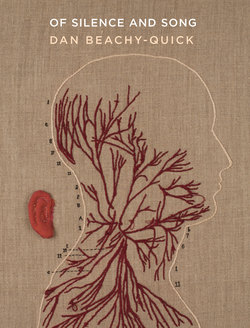Читать книгу Of Silence and Song - Dan Beachy-Quick - Страница 23
ОглавлениеJohn Keats writes to Fanny Brawne in February 1820: “I have found other thoughts intrude upon me. ‘If I should die,’ said I to myself, ‘I have left no immortal work behind me, nothing to make my friends proud of my memory, but I have lov’d the principle of beauty in all things, and if I had time I would have made myself remember’d.’”
The work of his greatest brilliance is behind him. The odes are littered with forms of immortal silence:
tuneless numbers
secrets
Thou still unravished bride of quietness,
Thou foster-child of silence and slow time
Heard melodies are sweet, but those unheard
Are sweeter
spirit ditties of no tone
Thou, silent form, dost tease us out of thought
As doth eternity
Darkling I listen
Fled is that music
a silent deep-disguised plot
To steal away
and leave my sense
Unhaunted quite of all but—nothingness?
Where are the songs of Spring? Ay, where are they?
Keats feels eternity’s silence. Some quality heaven and the gods keep to themselves. How is it we come to value most those qualities we are incapable of grasping? The figures on the urn, and only later, the ashes within it. To speak the words, “Thou still unravished bride of quietness” ravishes the bride away from her quietness, shatters the silence of her eternal life. The awful irony the poet lives in: to write immortal work requires the shattering of that silence where immortality might exist.
I want to say you cannot trespass into death, but I guess you can.
Orpheus.
Keats.
But trespass is reciprocal. What you trespass into also trespasses into you. From eternity, a little eternity. From death, a little death.
Keats writes to his friend Charles Brown: “I have an habitual feeling of my real life having past, and that I am leading a posthumous existence.” He’ll live another seven weeks, but he wouldn’t call it living. He’s already in eternity. Not heaven. He doesn’t believe in heaven. But he can hear that great silence that makes his fevered breath all the louder in his ears, silence that will unthread the Gordian knot of self into nothing, drawn into the silence the odes tried to, but could not, shatter. Drawn into the silence that mocks what’s known.
Or I think about it another way. You can’t ravish the bride of quietness. You can’t break apart her silence with your song. It’s the song that gets shattered by the silence it breaks. It’s immortality that wrecks the immortal work.
Mostly, it’s unthinkable.
Percy Bysshe Shelley dies with Keats’s third book open in his breast pocket. The pages of Lamia as rippled as a wave, last marker of the sea that drowned him.
The God, dove-footed, glided silently
Round bush and tree, soft-brushing, in his speed,
The taller grasses and full-flowering weed
Shelley’s body washes ashore after more than a week in the sea. Some accounts have much of his flesh eaten away or missing and much of what remains putrid with rot.
Louis Édouard Fournier paints the funeral scene. Shelley’s body dark on the dark wood just lit so there is no flame to see, only a lifting shroud of gray smoke. Three men stand close: Edward Trelawny, Leigh Hunt, and Lord Byron. A crowd in the background too dark to distinguish. A woman kneels near the edge. Maybe Mary, his wife.
The painting is somber, moving, but it’s a lie.
Trelawny brought to the beach some portable furnace, some oil, some wine, some salt. He collected wood. He writes: “The heat from the sun and the fire was so intense that the atmosphere was tremulous and wavy. The corpse fell open and the heart was laid bare. The frontal bone of the skull, where it had been struck with the mattock, fell off; and, as the back of the head rested on the red-hot bottom bars of the furnace, the brains literally seethed, bubbled, and boiled as in a cauldron, for a very long time.” Hunt stayed in his carriage. Byron watched from out in the ocean; he’d gone swimming in the sea. Somehow the heart didn’t burn, and Mary and Hunt fought over who should keep the miraculous relic. But as the critic Daisy Hay is quick to point out, it was likely not the poet’s heart, but his liver.
I don’t know why it’s on my mind. Byron alive and afloat in the very element that killed his friend. Hunt in the vehicle that, having brought him, will also take him away. Something about the distance each man has from the moment even as it’s occurring, and how the painting lies about that distance—or if it doesn’t exactly lie, allows us to discover some trick of honesty, which is to say, the painted men hide within themselves the distances to which they fled, and though we can’t see it on the canvas itself, contained within Hunt and Byron both is some silent gap undisclosed in which the truth of the event resides, invisible right there in what you see.
